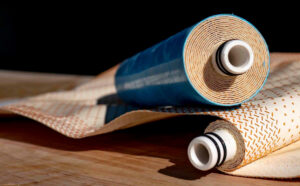High-purity water treatment plants and other industries that use membrane filtration rely on decades-old systems that are subject to reduced output and expensive maintenance. Aqua Membranes has been working on a new 3‑D-printed spacer technology to solve those issues. Municipal Water Leader spoke with CEO Craig Beckman about applications in which the company’s new technology can keep the water flowing.
Municipal Water Leader: Please tell us about your background and how you came to be in your current position.
Craig Beckman: I’ve been in the water industry for 30 years. I ended up here by mistake. I had gotten a degree in mechanical engineering and assumed I’d be working in the automotive or aerospace fields. But after college, I got a job with a water treatment startup based in Minneapolis called Osmonics, and I’ve been in the water industry ever since. I often tell people that the water industry connects to every industry, because everybody uses water in some form, whether they’re making jet fuel or semiconductors or raising pigs. I have worked both for big corporations like General Electric, specifically in its water business, and for small startups like this one. I joined Aqua Membranes as CEO about 4 years ago.
Municipal Water Leader: Please introduce the company.
Craig Beckman: We are a 10‑year-old company—a typical startup that literally started in somebody’s garage with funding from friends and family. I joined the company and then led the A-series fundraising. In addition to strategic investors, we have partnered with companies that want us to help them improve their water treatment products. Aqua Membranes uses printed spacer technology to develop and produce reverse osmosis (RO) elements with superior performance. An example of one of those companies is Pentair, a water treatment company based in Minneapolis. Pentair does a lot of residential water treatment work and has a line of RO equipment that is used in commercial food service. We’ve been working with the company to decrease the footprint of those machines by increasing the packing density of the RO membranes and increasing the machines’ efficiency as measured by how much water you get out versus how much energy you have to put in. We have also been working with Micron Technologies, a manufacturer of semiconductor memory chips, to reduce the energy required to make the same quality and quantity of water with printed spacer technology. The semiconductor industry uses a lot of water and is under tremendous water stress right now, given the huge demand for chips. Here in the United States, semiconductor chips are made primarily in the Southwest, which is struggling with drought. Internationally, they’re made in parts of China, Taiwan, and Singapore that also are struggling with water scarcity and drought. Last summer, one of our customers in Taiwan was literally trucking water into its facility because the area was in such a bad drought situation.
Municipal Water Leader: How did Aqua Membranes discover and develop its technology?

Craig Beckman: Our founder, Rodney Herrington, came up with the idea based on research he was doing at a different company. He left that company and decided to start his own venture. He thought, “All right, we need to make the membrane element differently if we want to get to the next level of performance.” The problem is that membrane elements last only a year in some applications and maybe 2–3 years in others. After that, they have to be replaced because they get dirty and fouled and scaled with minerals and suspended solids. This is because the feed spacer material that the industry currently uses—the netting material that lays between each layer of the membrane—acts almost like a snow fence: The snow hits the fence and just gets stuck there. Eventually, you can’t get the solids washed out, and you have to throw all the membranes away. Looking at the $3 billion membrane element business around the world, Mr. Herrington thought that it could be done better, using less energy and less water and sending less plastics into landfills. As an industry, we just had to think about the problem differently.
Municipal Water Leader: Please tell us about how your 3‑D-printed technology works.
Craig Beckman: Basically, what Aqua Membranes has done is reconstructed the way that membrane elements are put together. In the past, there were few choices—pretty much everyone used the same mesh material. We decided to remove the layer of plastic feed mesh and instead print dimensional forms right on the membrane surface. Think of it almost like a Braille surface on top of the membrane. We’re figuring out a 3‑D-printing technology—we sometimes call it 2½‑D, because we print extensively in the x and y dimensions and only a few millimeters in the z dimension. In a 3‑foot-square area of a membrane element, we might print 30,000 or more individual features, including lines, dots, squares, and chevrons. The pattern we use and the part of the membrane we print on can significantly improve its performance.
Advances in 3‑D printing technology have helped make this possible. You couldn’t do this 30 or 40 years ago because 3‑D printing, the different types of resins, and the curing technologies weren’t yet developed. Even today, it’s difficult. We’re printing on a very fragile surface, which is one of our biggest challenges: How do we print without damaging the membrane that we’re printing on? It’s very different than printing on a piece of paper.
Municipal Water Leader: Will this new technology cost more?
Craig Beckman: Yes: At this point, there will be a premium on the element up front, and the savings will be on life cycle cost. Customers will capture that premium back in the first year or two of operation.
Municipal Water Leader: How has the company developed since you came on board?
Craig Beckman: When I came on board, Aqua Membranes was still mostly a research company. Since then, we’ve completed proof of concepts and done some lab testing, and in the last couple of years, we have been the process of bringing more funding into the company and ramping up and commercializing our product.
We don’t have enough long-term data yet, but computer modeling shows us that we could significantly improve membrane life and save energy with our technology. That’s what makes us really excited about the technology. We can bring energy savings on day 1 because there is less wasted energy running through our membrane elements. We can also extend the membranes’ life significantly because the pattern is customized and printed in such a way that it doesn’t trap solids.
We’ve only taken a couple of customer orders at this point, but we expect to move into full manufacturing by the end of the year. The supply chain issues that everybody is struggling with have certainly hit us as well. I would say we’re about a year and a half behind where we expected to be in terms of ramping up production. We have a lot of customer demand, which is great, but our problem right now is fulfilling that demand.
Municipal Water Leader: What markets do you serve?
Craig Beckman: We are primarily focusing on the U.S. market at this point for our RO membrane elements. They are used in everything from homes to seawater desalination plants. We are primarily focusing on a couple of industry niches for now: wastewater reuse and small utility power production. The other products that we envision as part of our multigenerational product plan involve taking the technology to other similar membrane-filtration markets. The biggest markets for this type of technology for spiral-wound RO are seawater desalination, bottled water, food and beverage production, municipal drinking water, and some wastewater recycling. Orange County’s big wastewater recycling plant is a great example of what can be done. It takes about 100 million gallons a day of treated wastewater, runs it through membrane technologies, and then uses it to recharge the aquifer.
Municipal Water Leader: What is your vision for the future?
Craig Beckman: We’re hoping that the world will ramp up its manufacturing capacity, get back to prepandemic levels, and increase production from there. That would be good for us, because a lot of manufacturers use high-purity water. The semiconductor industry, for example, is expanding right now and looking at new technologies as it builds new facilities. Companies are asking for state-of-the-art water treatment technology. We want to be part of that solution: to bring innovation while helping companies use less energy.
Craig Beckman is CEO of Aqua Membranes. He can be reached at craig@aquamembranes.com.

